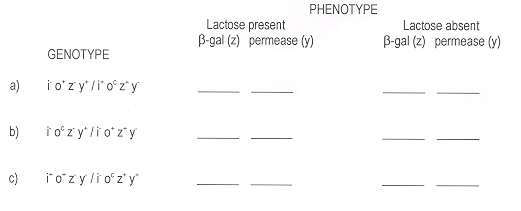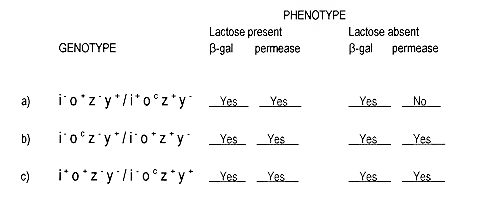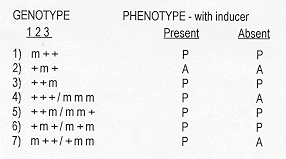
OPERON PRACTICE PROBLEMS
1. The following are the genotypes of partial diploid bacteria, mutant in one or more genes associated with the LAC OPERON. For each bacterium, indicate in the spaces provided whether beta-galactosidase and whether permease will be produced under conditions when lactose is present and when lactose is absent. Use "yes" to indicate that the enzyme is produced (in functional form); use "no" to indicate that the enzyme either is not produced or is not functional.


2. Three "genes" have been identified in E. coli and shown by genetic linkage analysis to be present in the order 1 - 2 - 3. In the table below "m" signifies mutated, "+" signifies wild-type, "P" means the enzyme is present in large amounts, while "A" means the enzyme is absent. Based on the information in the table, indicate which gene (1,2, or 3) is the gene that encodes the regulator protein, which is the operator, and which is the structural gene.
| GENOTYPE | PHENOTYPE | ||||
| 1 2 3 | Inducer Present | Inducer Absent | |||
| 1) | m++ | P | P | ||
| 2) | +m+ | A | A | ||
| 3) | ++m | P | P | ||
| 4) | +++ / mmm | P | A | ||
| 5) | ++m / mm+ | P | P | ||
| 6) | +m+ / m+m | P | P | ||
| 7) | m++ / +mm | P | A |

Bacteria in Group 2 are most likely to contain the mutation in the structural gene. The only other explanation for the observation that this group does not produce enzyme in the presence of inducer would be if the mutant encoded a super-repressor. Group 4, the partial diploid, demonstrates that NONE of the mutants is a super-repressor. If it were, the super-repressor encoded by the mmm chromosome would repress the wild-type chromosome, even when lactose is present. The data show, however, that the partial diploid makes enzyme in the presence of lactose. There is no super-repressor mutation. Thus, gene 2 is the structural gene.
Group 1 and 3 are constitutive mutants; thus gene 1 and 3 are the operator and the regulator protein gene, but we cannot yet determine which is which.
A mutation in the operator (constitutive operator) when paired with a wild-type structural gene allele, will be cis-acting and will give a constitutive phenotype (enzymes produced when lactose absent). Groups 5 and 6 exhibit this phenotype. To identify the operator gene, look for the chromosome pairing a mutant with a wild-type gene 2 allele. Gene 3 is mutant when gene 2 is normal (++m/mm+ in Group 5 and +m+/m+min Group 6). Thus, gene 3 must be the operator.
A wild-type regulator protein will compensate for a defective regulator protein. Thus the wild-type allele will be trans-acting, and partial diploids will produce enzyme when the inducer is present. Group 7 exhibits normal gene regulation in the presence and absence of inducer. The phenotype of this group tells us that gene 1 encodes the regulator protein.